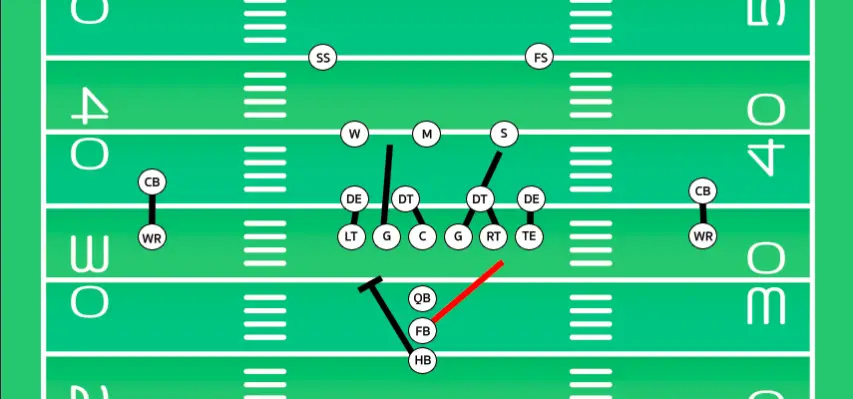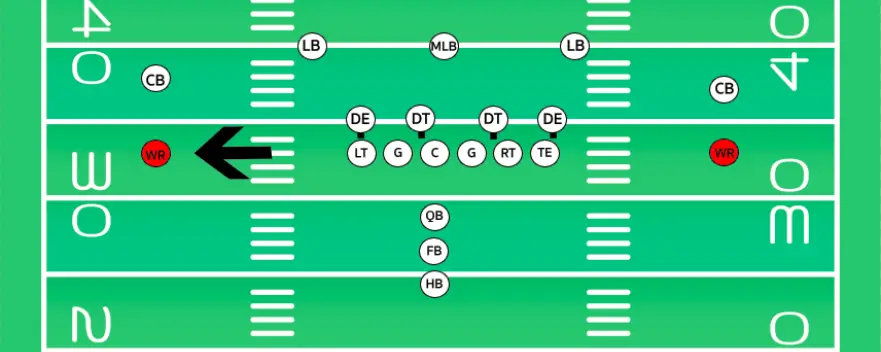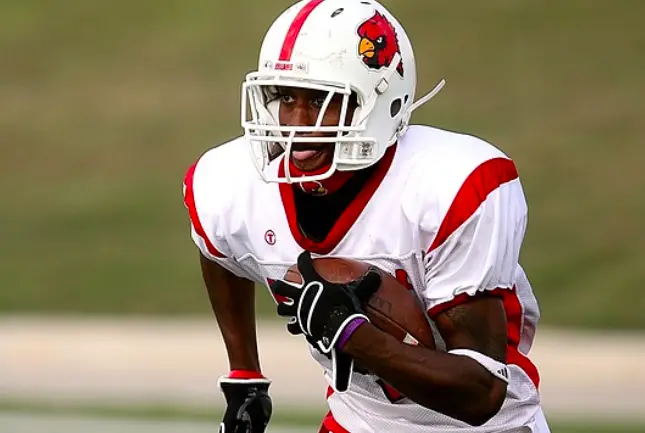In football, a wide receiver is an offensive player that is responsible for catching passes from the quarterback. The purpose of a wide receiver is to get down the field and separate themselves far enough away from a defender in order to catch a pass.
There are typically two wide receivers on the field at all times though there can be as many as four receivers and in some cases none.
The wide receiver position typically plays head-to-head against the cornerback position. Cornerbacks are tasked with the responsibility of stopping receivers from catching the ball.
This article is going to break down what a wide receiver does on the football field as well as, the key attributes and build of this position.
What does a wide receiver do in football?
The main responsibility of a wide receiver in football is to catch passes from the quarterback.
On passing plays wide receivers will run downfield and separate themselves from opponents. Once open these players will be expected to catch passes thrown their way and then progress down the field.
Wide receivers also play a small role in blocking on rushing plays.
Catching Passes as a Wide Receiver

The most important aspect of the wide receiver position is the responsibility of catching passes. After all, completing passes is the most effective way for the offense to make their way down the field.
And though several different positions are able to catch passes it receivers that do the bulk of catching. The job of effectively catching passes from the quarterback is so important for an offense that receivers are typically one of the highest-paid positions on the offense.
Only the quarterback and on some occasions the left tackle tend to make more money than the teams top wide receiver.
Blocking as a Wide Receiver

Blocking is another responsibility that falls onto wide receivers. Though their blocking is not as important as the offensive line it is still important the receivers are able to block their assigned defender.
On running plays wide receivers are typically tasked with blocking the defender that is covering them.
This isn’t a terribly hard assignment as receivers are usually covered by smaller players. Though a receiver that can block well can be quite helpful for a team’s outside run game.
Blocking may also come into play when another receiver catches the ball down field.
Effectively pulling off a downfield block can turn a routine catch into a long touchdown.
Spreading Out The Defense
Though not one of the main aspects of a receiver’s game they are sometimes assigned the role of spreading out the defense. In these situations, receivers will run to locations on the field where the ball is not going.
For example, a receiver may run in a straight line down the field to start the play. This will pull the defenders covering him far from the line of scrimmage.
This makes it easier for the quarterback to complete short or mid-range passes as there are fewer defenders in the area.
Wide Receiver Attributes
Great Hands
Having great hands is one of the most important aspects of being a wide receiver. Most receivers are only going to get several targets a game making it very important that each pass is caught.
If a receiver has trouble consistently catching the ball then it is likely he won’t have a very long career.
Route Running
Route running is another very important aspect of playing the wide receiver position. In order to get balls thrown your way, you need to get open. And to get open you need to run good routes.
Running these routes effectively to will allow you to gain separation from defenders. By cutting quickly and using good footwork receivers will find they will be much more effective at their position.
Speed
Speed isn’t the end all be all for receivers but it certainly plays a large role. Some receivers rely solely on speed to beat defenders. And if you are fast enough this is a reliable strategy. While possession receivers use their larger frame to make up for a lack of speed.
Either way, having speed at this position is always going to be beneficial for a receiver.
Build
Wide receiver builds are fairly broad across the board as some rely on speed while others rely on strength. For the most part it can be said the wide receivers are usually the lightest players on the offense.
The build of a wide receiver is typically a taller skinnier player with a large wingspan. That being said many short players have excelled at the wide receiver position. Though those smaller receivers usually have elite speed and agility.
Wide receivers carry little no fat on their bodies and though some are muscular most carry less muscle mass than the rest of the offensive positions.
Positioning

Wide receivers positioning on plays is given away by their name. These players line up furthest away from the formation right near the sideline. On most plays, there are two wide receivers with one lining up near each sideline.
Placing these players out wide means the defense has to move two players away from the formation. This makes it easier for the rest of the offense to run their plays.
Some receivers line up in the slot, this is the area of the field in between the offensive line and the wide receiver. Receivers that tend to play the majority of their snaps here are referred to as slot receivers.
Concluding Thoughts
We hope this guide has taught you everything you need to know about the receiver position in football. If you have any more questions regarding this position please be sure to reach out and we’ll be happy to answer.

